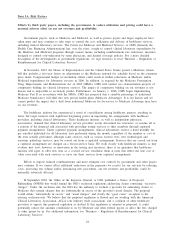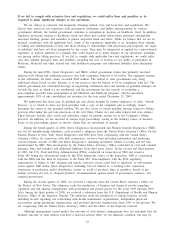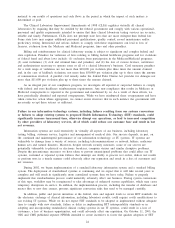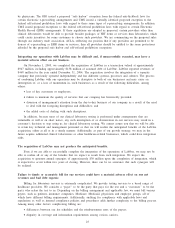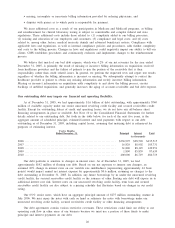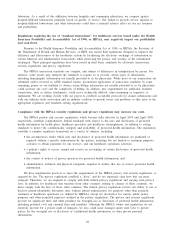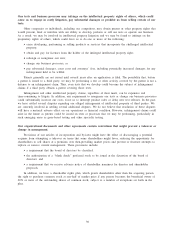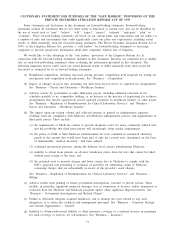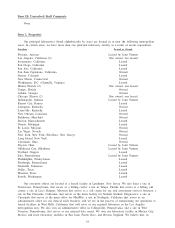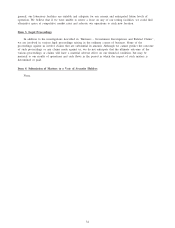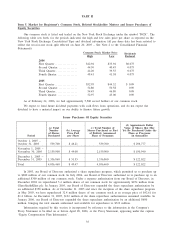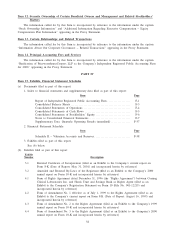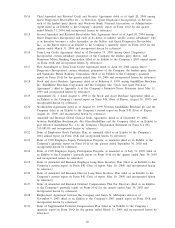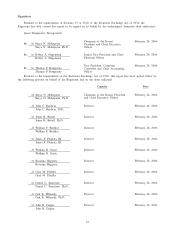Quest Diagnostics 2005 Annual Report Download - page 49
Download and view the complete annual report
Please find page 49 of the 2005 Quest Diagnostics annual report below. You can navigate through the pages in the report by either clicking on the pages listed below, or by using the keyword search tool below to find specific information within the annual report.(h) Denial of CLIA certification or other licenses for any of our clinical laboratories under the CLIA
standards, revocation or suspension of the right to bill the Medicare and Medicaid programs or other
adverse regulatory actions by federal, state and local agencies. See “Business – Regulation of Clinical
Laboratory Operations’’.
(i) Changes in federal, state or local laws or regulations, including changes that result in new or increased
federal or state regulation of commercial clinical laboratories, including regulation by the FDA.
(j) Inability to achieve expected benefits from our acquisitions of other businesses. See “Business –
Corporate Strategy and Growth Opportunities – Growth’’.
(k) Inability to achieve additional benefits from our Six Sigma and standardization initiatives.
(l) Adverse publicity and news coverage about the clinical laboratory industry or us.
(m) Computer or other IT system failures that affect our ability to perform tests, report test results or
properly bill customers, including potential failures resulting from the standardization of our IT
systems and other system conversions, telecommunications failures, malicious human acts (such as
electronic break-ins or computer viruses) or natural disasters. See “Business – Information Systems’’
and “Business – Billing’’.
(n) Development of technologies that substantially alter the practice of laboratory medicine, including
technology changes that lead to the development of more cost-effective tests such as (1) point-of-care
tests that can be performed by physicians in their offices, (2) esoteric tests that can be performed by
hospitals in their own laboratories or (3) home testing that can be carried out without requiring the
services of clinical laboratories. See “Business – Competition’’ and “Business – Regulation of Clinical
Laboratory Operations’’.
(o) Issuance of patents or other property rights to our competitors or others that could prevent, limit or
interfere with our ability to develop, perform or sell our tests or operate our business.
(p) Development of tests by our competitors or others which we may not be able to license, or usage of
our technology or similar technologies or our trade secrets by competitors, any of which could
negatively affect our competitive position.
(q) Regulatory delay or inability to commercialize newly licensed tests or technologies or to obtain
appropriate reimbursements for such tests.
(r) Inability to obtain or maintain adequate patent and other proprietary rights protections of our products
and services or to successfully enforce our proprietary rights.
(s) Impact of any national healthcare information network and the adoption of standards for health
information technology interoperability that are incompatible with existing software and hardware
infrastructure requiring widespread replacement of systems and/or software.
(t) The impact of the privacy regulations, security regulations and standards for electronic transactions
regulations issued under HIPAA and any applicable state laws or regulations. See “Business – Privacy
and Security of Health Information; Standard Transactions’’.
(u) Inability to promptly or properly bill for our services or to obtain appropriate payments for services
that we do bill. See “Business – Billing’’.
(v) Changes in interest rates and changes in our credit ratings from Standard & Poor’s and Moody’s
Investor Services causing an unfavorable impact on our cost of and access to capital.
(w) Inability to hire and retain qualified personnel or the loss of the services of one or more of our key
senior management personnel.
(x) Terrorist and other criminal activities, hurricanes, earthquakes or other natural disasters, which could
affect our customers, transportation or systems, or our facilities, and for which insurance may not
adequately reimburse us.
32


